Euclid's first images: the dazzling edge of darkness
7 November 2023
The European Space Agency (ESA) mission Euclid, whose massive optical camera was built by an international team led by UCL researchers, has released its first full-colour images of the cosmos.
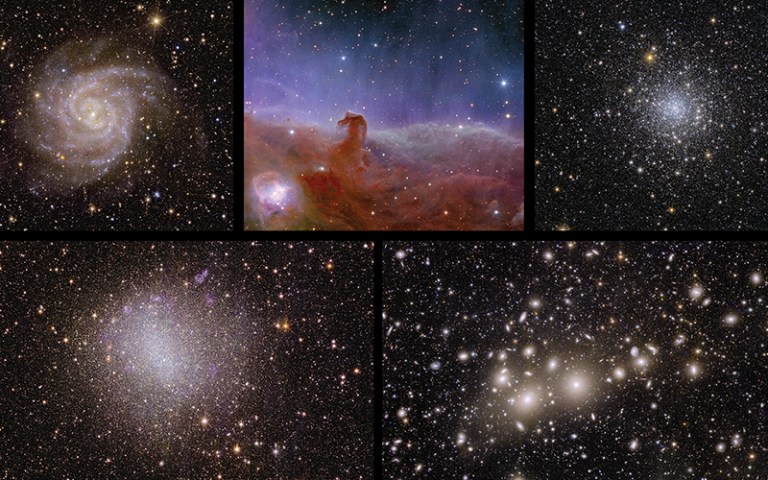
This is the first time a telescope has been able to create such razor-sharp astronomical images across such a large patch of the sky, and looking so far into the distant Universe.
Euclid, the dark Universe detective, has a difficult task: to investigate how dark matter and dark energy have made our Universe look like it does today. 95% of our cosmos appears to be made of these mysterious ‘dark’ entities. But we don’t understand what they are because their presence causes only very subtle changes in the appearance and motions of the things we can see.
To reveal the ‘dark’ influence on the visible Universe, over the next six years Euclid will observe the shapes, distances and motions of billions of galaxies out to 10 billion light-years away. By doing this, it will create the largest cosmic 3D map ever made.
What makes Euclid’s view of the cosmos special is its ability to create a remarkably sharp visible and infrared image across a huge part of the sky in just one sitting.
The images released today showcase this special capacity: from bright stars to faint galaxies, the observations show the entirety of these celestial objects, while remaining extremely sharp, even when zooming in on distant galaxies.
They were created by combining data from Euclid’s two instruments: VIS, a visible light camera, and the Near Infrared Spectrometer and Photometer (NISP), which captures light from the infrared spectrum.
Professor Mark Cropper (Mullard Space Science Laboratory at UCL), who has led on designing and developing the VIS optical camera over 16 years, working with teams at UCL, Open University and across Europe, said: “The quality of these very beautiful images shows that Euclid is poised to carry out its mission to study dark matter and dark energy and will enable a wide range of other science across the whole of astronomy.
“Beyond the more prominent objects the sky is filled with background faint galaxies seen as they were long ago.
“The Euclid survey will cover most of the sky not obscured by our Milky Way and it is these objects which will tell us about dark matter and dark energy.”
Professor Carole Mundell, ESA Director of Science, said: “Dark matter pulls galaxies together and causes them to spin more rapidly than visible matter alone can account for; dark energy is driving the accelerated expansion of the Universe. Euclid will for the first time allow cosmologists to study these competing dark mysteries together.
“Euclid will make a leap in our understanding of the cosmos as a whole, and these exquisite Euclid images show that the mission is ready to help answer one of the greatest mysteries of modern physics.”
René Laureijs, ESA’s Euclid Project Scientist, said: “We have never seen astronomical images like this before, containing so much detail. They are even more beautiful and sharp than we could have hoped for, showing us many previously unseen features in well-known areas of the nearby Universe. Now we are ready to observe billions of galaxies, and study their evolution over cosmic time.”
The Perseus Cluster of galaxies
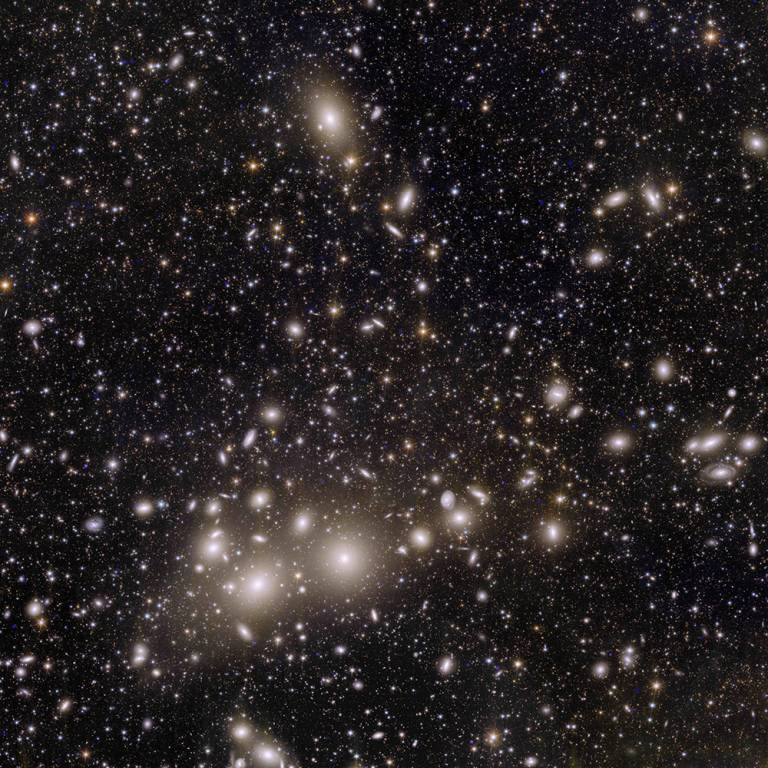 This incredible snapshot from Euclid is a revolution for astronomy. The image shows 1,000 galaxies belonging to the Perseus Cluster, and more than 100,000 additional galaxies further away in the background.
This incredible snapshot from Euclid is a revolution for astronomy. The image shows 1,000 galaxies belonging to the Perseus Cluster, and more than 100,000 additional galaxies further away in the background.
Many of these faint galaxies were previously unseen. Some of them are so distant that their light has taken 10 billion years to reach us. By mapping the distribution and shapes of these galaxies, cosmologists will be able to find out more about how dark matter shaped the Universe that we see today.
This is the first time that such a large image has allowed us to capture so many Perseus galaxies in such a high level of detail. Perseus is one of the most massive structures known in the Universe, located ‘just’ 240 million light years away from Earth.
Astronomers demonstrated that galaxy clusters like Perseus can only have formed if dark matter is present in the Universe. Euclid will observe numerous galaxy clusters like Perseus across cosmic time, revealing the ‘dark’ element that holds them together.
Spiral galaxy IC 342
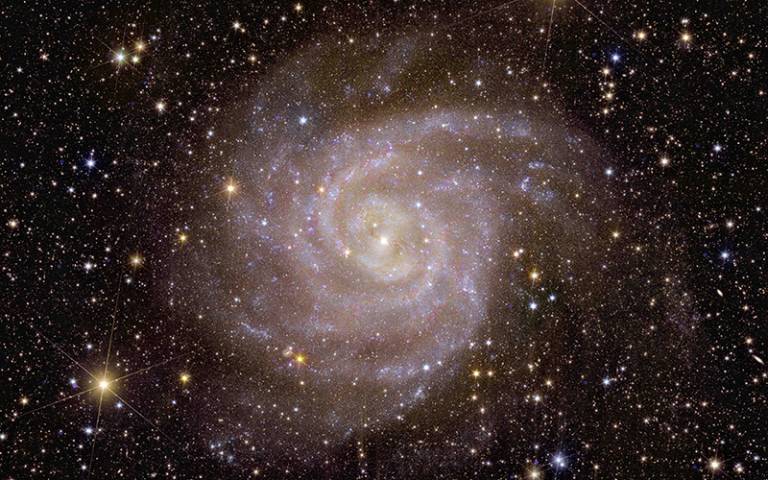 Over its lifetime, our dark Universe detective will image billions of galaxies, revealing the unseen influence that dark matter and dark energy have on them. That’s why it’s fitting that one of the first galaxies that Euclid observed is nicknamed the ‘Hidden Galaxy’, also known as IC 342 or Caldwell 5. Thanks to its infrared view, Euclid has already uncovered crucial information about the stars in this galaxy, which is a look-alike of our Milky Way.
Over its lifetime, our dark Universe detective will image billions of galaxies, revealing the unseen influence that dark matter and dark energy have on them. That’s why it’s fitting that one of the first galaxies that Euclid observed is nicknamed the ‘Hidden Galaxy’, also known as IC 342 or Caldwell 5. Thanks to its infrared view, Euclid has already uncovered crucial information about the stars in this galaxy, which is a look-alike of our Milky Way.
Irregular galaxy NGC 6822
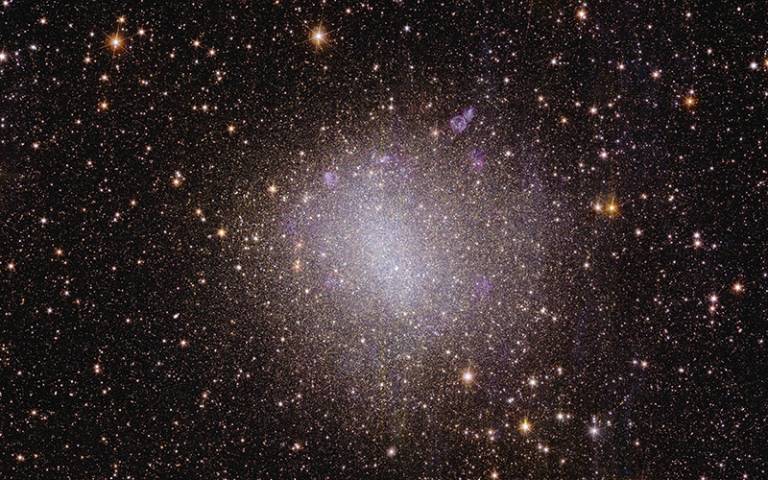 To create a 3D map of the Universe, Euclid will observe the light from galaxies out to 10 billion light-years away. Most galaxies in the early Universe don’t look like the quintessential neat spiral, but are irregular and small. They are the building blocks for bigger galaxies like our own, and we can still find some of these galaxies relatively close to us. This first irregular dwarf galaxy that Euclid observed is called NGC 6822 and is located close by, just 1.6 million light years from Earth.
To create a 3D map of the Universe, Euclid will observe the light from galaxies out to 10 billion light-years away. Most galaxies in the early Universe don’t look like the quintessential neat spiral, but are irregular and small. They are the building blocks for bigger galaxies like our own, and we can still find some of these galaxies relatively close to us. This first irregular dwarf galaxy that Euclid observed is called NGC 6822 and is located close by, just 1.6 million light years from Earth.
Globular cluster NGC 6397
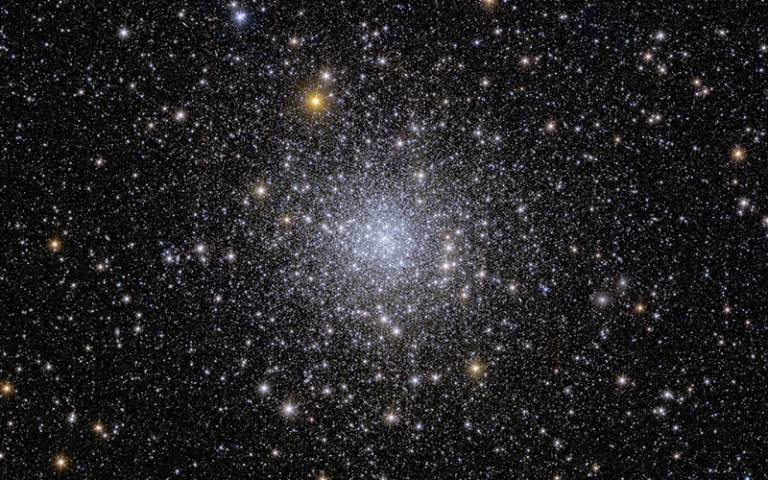 This sparkly image shows Euclid’s view on a globular cluster called NGC 6397. This is the second-closest globular cluster to Earth, located about 7,800 light-years away. Globular clusters are collections of hundreds of thousands of stars held together by gravity. Currently no other telescope than Euclid can observe an entire globular cluster in one single observation, and at the same time distinguish so many stars in the cluster. These faint stars tell us about the history of the Milky Way and where dark matter is located.
This sparkly image shows Euclid’s view on a globular cluster called NGC 6397. This is the second-closest globular cluster to Earth, located about 7,800 light-years away. Globular clusters are collections of hundreds of thousands of stars held together by gravity. Currently no other telescope than Euclid can observe an entire globular cluster in one single observation, and at the same time distinguish so many stars in the cluster. These faint stars tell us about the history of the Milky Way and where dark matter is located.
The Horsehead Nebula
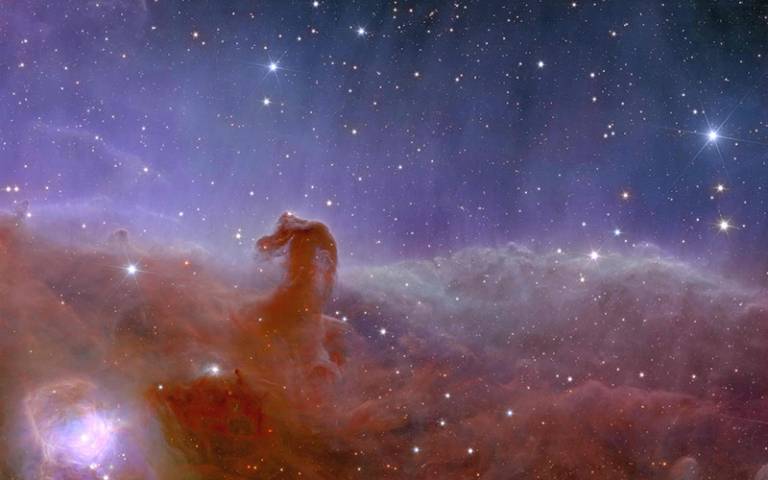 Euclid shows us a spectacularly panoramic and detailed view of the Horsehead Nebula, also known as Barnard 33 and part of the constellation Orion. In Euclid’s new observation of this stellar nursery, scientists hope to find many dim and previously unseen Jupiter-mass planets in their celestial infancy, as well as young brown dwarfs and baby stars.
Euclid shows us a spectacularly panoramic and detailed view of the Horsehead Nebula, also known as Barnard 33 and part of the constellation Orion. In Euclid’s new observation of this stellar nursery, scientists hope to find many dim and previously unseen Jupiter-mass planets in their celestial infancy, as well as young brown dwarfs and baby stars.
The five Euclid images can be viewed at their full resolution from the ESA website.
New discoveries, soon
Euclid’s first view of the cosmos is not only beautiful, but also immensely valuable for the scientific community.
Firstly, it showcases that Euclid’s telescope and instruments are performing extremely well and that astronomers can use Euclid to study the distribution of matter in the Universe and its evolution at the largest scales. Combining many observations of this quality covering large areas of the sky will show us the dark and hidden parts of the cosmos.
Secondly, each image individually contains a wealth of new information about the nearby Universe. Yannick Mellier, Euclid Consortium lead, said: “In the coming months, scientists in the Euclid Consortium will analyse these images and publish a series of scientific papers in the journal Astronomy & Astrophysics, together with papers about the scientific objectives of the Euclid mission and the instrument performance.”
And finally, these images take us beyond the realm of dark matter and dark energy, also showing how Euclid will create a treasure trove of information about the physics of individual stars and galaxies.
Getting ready for routine observations
Euclid launched to the Sun-Earth Lagrange point 2 on a SpaceX Falcon 9 rocket from Cape Canaveral Space Force Station in Florida, USA, at 17:12 CEST on 1 July 2023. In the months after launch, scientists and engineers have been engaged in an intense phase of testing and calibrating Euclid’s scientific instruments. The team is doing the last fine-tuning of the spacecraft before routine science observations begin in early 2024.
Over six years, Euclid will survey one third of the sky with unprecedented accuracy and sensitivity. As the mission progresses, Euclid’s bank of data will be released once per year, and will be available to the global scientific community via the Astronomy Science Archives hosted at ESA’s European Space Astronomy Centre in Spain.
About Euclid
Euclid is a European mission, built and operated by ESA, with contributions from NASA. The Euclid Consortium – consisting of more than 2,000 scientists from 300 institutes in 13 European countries, the US, Canada and Japan – is responsible for providing the scientific instruments and scientific data analysis.
Links
- ESA story
- UCL News story – ‘Space telescope to shed light on dark universe’
- UCL News story – ‘First-light images from Euclid-VIS’
- Professor Mark Cropper’s academic profile
- Mullard Space Science Laboratory at UCL
- UCL Physics & Astronomy
- UCL Mathematical & Physical Sciences
Images
- Credit: ESA/Euclid/Euclid Consortium/NASA, image processing by J.-C. Cuillandre (CEA Paris-Saclay), G. Anselmi; CC BY-SA 3.0 IGO
Media contact
Mark Greaves
E: m.greaves [at] ucl.ac.uk
 Close
Close

